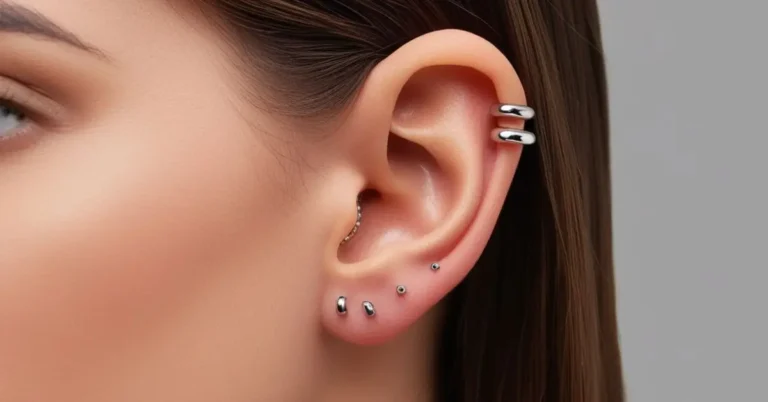The snug piercing is a unique and bold choice for body art enthusiasts, offering a stylish way to showcase individuality. This piercing goes through the anti-helix part of your ear and is known for its distinctive, edgy appearance. However, before deciding on this piercing, it’s crucial to understand its pros, cons, aftercare, and healing process. Let’s dive deep into the world of snug piercings.
What is a Snug Piercing?
A snug piercing is a cartilage piercing that goes through the anti-helix, the inner ridge of the ear, located close to the ear canal. Its placement makes it a standout, often drawing attention due to its visible yet subtle charm. Unlike traditional lobe piercings, the snug is unique in its horizontal orientation and requires a curved barbell or similar jewelry.
Pain Level
One common concern is the pain associated with snug piercings. Since it involves thick cartilage, this piercing is considered one of the more painful ones. The discomfort can vary depending on your pain tolerance, but you might feel a sharp pressure during the procedure and mild soreness afterward. Choosing an experienced piercer can significantly reduce the discomfort and ensure a clean, precise piercing.
Healing Time
The snug piercing has a longer healing time compared to other ear piercings, often taking 4–6 months to heal fully. In some cases, it might take up to a year. The slow healing process is due to the dense cartilage in the area, which receives less blood flow than softer tissue. Proper aftercare is essential to prevent complications such as infections or bumps.
Aftercare Tips
Taking care of your snug piercing is key to a smooth healing process:
- Clean Twice Daily: Use saline solution or a piercing aftercare spray. Avoid harsh chemicals like alcohol or peroxide.
- Hands-Off Policy: Refrain from touching or rotating the jewelry unnecessarily.
- Avoid Irritants: Keep hair, phones, and headphones away from the piercing.
- Mind Your Sleep: Avoid sleeping on the pierced side to reduce pressure.
- Watch for Signs of Infection: Redness, swelling, or unusual discharge should be addressed promptly with your piercer or a healthcare professional.
Jewelry Options
The snug piercing is typically adorned with a curved barbell, which fits well within the anti-helix’s curve. You can choose from materials like surgical steel, titanium, or gold to minimize the risk of allergic reactions. After healing, you can experiment with decorative options like gemstones, pearls, or unique shapes for a personalized touch.
Faux Snug Piercing: A Stylish Alternative
If you love the look but dread the healing time or pain, a faux snug piercing might be for you. This involves two separate piercings—a conch and an outer helix—placed to mimic the appearance of a snug piercing. It allows for more versatility in jewelry choice and often heals faster since each piercing is less invasive.
Pros and Cons
| Aspect | Pros | Cons |
|---|---|---|
| Aesthetic Appeal | Unique and eye-catching | Limited jewelry options |
| Pain Level | Worth the style payoff | Considered more painful than most |
| Healing Time | Achievable with commitment | Long and prone to complications |
| Aftercare | Promotes good hygiene habits | Requires consistent effort |
| Versatility | Complements other ear piercings | Not suitable for all ear anatomies |
Snug Piercing Cost
The cost of a snug piercing varies by location and piercer, generally ranging from $30 to $70. Always prioritize quality over cost; a reputable piercer will follow hygienic practices and use sterilized equipment, which are vital for your safety.
Finding the Right Piercer
When choosing a piercer, consider:
- Experience: Look for professionals with a strong track record in cartilage piercings.
- Studio Hygiene: The piercing studio should be clean and follow proper sterilization protocols.
- Reviews: Check online reviews or ask for recommendations.
FAQs
1. Is a snug piercing worth it?
Yes, if you’re drawn to its unique look and are committed to proper aftercare.
2. Can a snug piercing close up?
Like any piercing, it can close if you remove the jewelry, especially in the first few months.
3. What are the risks of a snug piercing?
Potential risks include infections, cartilage bumps, and rejection. Following aftercare instructions minimizes these risks.
4. Can I swim after getting a snug piercing?
It’s best to avoid swimming for at least two months to reduce the risk of infection from unclean water.
5. What’s the difference between a snug and faux snug piercing?
A snug piercing is a single cartilage piercing, while a faux snug mimics the look with two separate piercings.

